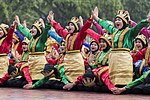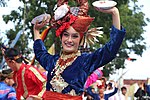Bambangan Cakil
 Bambangan Cakil performance | |
| Native name | ꧋ꦧꦩ꧀ꦧꦔꦤ꧀ꦕꦏꦶꦭ꧀ (Javanese) Tari Klasik Bambangan Cakil (Indonesian) |
|---|---|
| Instrument(s) | Gamelan |
| Inventor | Central Javanese |
| Origin | Indonesia |

| Bambangan Cakil |
|---|
|
| Burma |
| Cambodia |
| Indonesia |
|
| Laos |
| Malaysia |
| Philippines |
| Singapore |
| Thailand |
|
| Vietnam |
Bambangan Cakil (from Javanese ꧋ꦧꦩ꧀ꦧꦔꦤ꧀ꦕꦏꦶꦭ꧀) is a classical dance-drama[1] of Central Javanese people in—particularly—Central Java, Indonesia.[2] This dance-drama demonstrates wayang performance due to the movement is adopted from one of the scenes in wayang kulit performance, that is the Perang Kembang scene.[3] The Perang Kembang told about war between kesatria and raksasa. The kesatria has soft and gentle characters, while the raksasa is described as a character who is rough and violent.
The dance-drama war[4] between kesatria (Bambangan) against raksasa (Cakil) could also be used as a place for a dalang's judgment in moving a puppet.
Philosophy
[edit]In Javanese culture, kesatria are always considered to be good figures, willing to defend the truth, to help others, etc.[5] The kesatria title is given, rather than being heredity. For example, in the Mahabharata story, Kurawa does not have a kesatria title, even though he has the same ancestors as the Pandava.
On the other hand, raksasa are characterised as rough, violent and dynamic.
Characterizations
[edit]In the Bambangan Cakil dance-drama, Arjuna is depicted as kesatria, while Cakil is depicted as raksasa.[6]
See also
[edit]References
[edit]- ^ Widiarto, Bambang (27 June 1991). "Tari Klasik"Bambangan Cakil"". Retrieved 30 October 2020.
{{cite journal}}: Cite journal requires|journal=(help) - ^ "Tari Bambangan Cakil Tarian Tradisional dari Jawa Tengah". Negeriku Indonesia. Retrieved 30 October 2020.
- ^ Murtiyoso (2009). Perang Kembang dan Bambangan-Cakil "Tontonan Bermakna Ganda". Surakarta: ISI Press.
- ^ Handayani, Langlang; Prasetya Aji, Mahardika; Susilo; Marwoto, Putut (2016). "Bringing Javanesse Traditional Dance into Basic Physics Class: Exemplifying Projectile Motion through Video Analysis". Journal of Physics: Conference Series. 739 (1): 012073. Bibcode:2016JPhCS.739a2073H. doi:10.1088/1742-6596/739/1/012073.
- ^ Murtiyoso (2004). Pertumbuhan dan Perkembangan Seni Pertunjukan Wayang. Surakarta: ISI Press.
- ^ "Tari Bambangan Cakil". Dinas Kearsipan dan Perpustakaan Provinsi Jawa Tengah. Retrieved 30 October 2020.[permanent dead link]
External links
[edit]- Nama tari-tarian Indonesia Archived 2011-06-13 at the Wayback Machine







